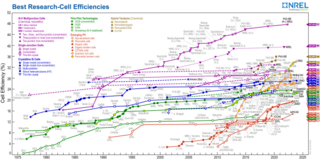
Photovoltaics (PV) is the conversion of light into electricity using semiconducting materials that exhibit the photovoltaic effect, a phenomenon studied in physics, photochemistry, and electrochemistry. The photovoltaic effect is commercially used for electricity generation and as photosensors.

Dow Corning Corporation, was an American multinational corporation headquartered in Midland, Michigan, United States, and was originally established as a joint venture between The Dow Chemical Company and Corning Incorporated. In 2016, Dow bought out Corning, making Dow Corning a 100% Dow subsidiary. After a brief existence as a DowDuPont-owned company, Dow spun out from DowDuPont on April 1, 2019. The new company, Dow Silicones Corporation, which is wholly owned by Dow, specializes in silicone and silicon-based technology, and is the largest silicone product producer in the world.

A solar cell or photovoltaic cell is an electronic device that converts the energy of light directly into electricity by means of the photovoltaic effect. It is a form of photoelectric cell, a device whose electrical characteristics vary when exposed to light. Individual solar cell devices are often the electrical building blocks of photovoltaic modules, known colloquially as "solar panels". The common single-junction silicon solar cell can produce a maximum open-circuit voltage of approximately 0.5 to 0.6 volts.
Hanwha Solutions Corporation is a multinational energy services, petrochemical, and real estate development company headquartered in Seoul, South Korea. The company is part of the Hanwha Group, a large South Korean business conglomerate. Founded in 1965 as Hanwha Chemical, the company was rebranded as Hanwha Solutions in January 2020 when Hanwha Chemical merged with Hanwha Q Cells & Advanced Materials, which itself was formed out of a 2018 merger. The company added the Hanwha Galleria and Hanwha City Development real estate companies to its portfolio in April 2021. The Galleria division and the Advanced Materials division were spun off. The Electronic Materials business, which had remained part of the Advanced Materials division, was also transferred to a subsidiary of the company.

The Renewable Energy Corporation (REC) is a solar power company with headquarters in Singapore. REC produces silicon materials for photovoltaics (PV) applications and multicrystalline wafers, as well as solar cells and modules. It is a wholly-owned subsidiary of Reliance New Solar Energy Limited.
Sharp Solar, a subsidiary of Sharp Electronics, is a solar energy products company owned by Sharp Corporation and based in Osaka, Japan.

China is the largest market in the world for both photovoltaics and solar thermal energy. China's photovoltaic industry began by making panels for satellites, and transitioned to the manufacture of domestic panels in the late 1990s. After substantial government incentives were introduced in 2011, China's solar power market grew dramatically: the country became the world's leading installer of photovoltaics in 2013. China surpassed Germany as the world's largest producer of photovoltaic energy in 2015, and became the first country to have over 100 GW of total installed photovoltaic capacity in 2017.
SunEdison, Inc. is a renewable energy company headquartered in the U.S. In addition to developing, building, owning, and operating solar power plants and wind energy plants, it also manufactures high purity polysilicon, monocrystalline silicon ingots, silicon wafers, solar modules, solar energy systems, and solar module racking systems. Originally a silicon-wafer manufacturer established in 1959 as the Monsanto Electronic Materials Company, the company was sold by Monsanto in 1989.
Monocrystalline silicon, more often called single-crystal silicon, in short mono c-Si or mono-Si, is the base material for silicon-based discrete components and integrated circuits used in virtually all modern electronic equipment. Mono-Si also serves as a photovoltaic, light-absorbing material in the manufacture of solar cells.

Between 1992 and 2023, the worldwide usage of photovoltaics (PV) increased exponentially. During this period, it evolved from a niche market of small-scale applications to a mainstream electricity source. From 2016-2022 it has seen an annual capacity and production growth rate of around 26%- doubling approximately every three years.
Nitol SolarGroup Ltd. was a vertically integrated company group based in Usolye-Sibirskoye, Russia. The company had two plants and was intended to produce solar-grade polycrystalline silicon from trichlorsilane by Siemens-process for solar energy applications. The company stopped all activities in 2012, fired all employees, went bankrupt, and closed in 2019. The company's facilities were being dismantled in 2022.
GCL-Poly, founded in 1996, is a subsidiary of Golden Concord Group Limited (GCL), a green energy supplier in China, providing power and heat via cogeneration, incineration and wind power. As of 2009 it was the largest supplier of polysilicon in China, and is also a supplier of electronic wafers for the solar industry.

Crystalline silicon or (c-Si) Is the crystalline forms of silicon, either polycrystalline silicon, or monocrystalline silicon. Crystalline silicon is the dominant semiconducting material used in photovoltaic technology for the production of solar cells. These cells are assembled into solar panels as part of a photovoltaic system to generate solar power from sunlight.

There are currently many research groups active in the field of photovoltaics in universities and research institutions around the world. This research can be categorized into three areas: making current technology solar cells cheaper and/or more efficient to effectively compete with other energy sources; developing new technologies based on new solar cell architectural designs; and developing new materials to serve as more efficient energy converters from light energy into electric current or light absorbers and charge carriers.

Polycrystalline silicon, or multicrystalline silicon, also called polysilicon, poly-Si, or mc-Si, is a high purity, polycrystalline form of silicon, used as a raw material by the solar photovoltaic and electronics industry.
Hemlock Semiconductor (HSC) is the largest producer of hyper-pure polysilicon headquartered in the United States. Polycrystalline silicon, also called polysilicon, is a high purity, polycrystalline form of silicon, used as a raw material by the solar photovoltaic and electronics industry.
Qinghai Golmud Solar Park is a photovoltaic power station located in Golmud, Qinghai Province, China. It is 20.16 megawatt-peak (MWp), and was completed in 2011 by Longyuan Power. It uses 18.63079 MW of polycrystalline silicon solar cell modules and 1.530144 MW of amorphous silicon thin film modules. The polysilicon modules are by Yingli, and the amorphous ones are from Golden Sun Solar (GS-Solar). The capacity factor is expected to be 0.189.
Daqo New Energy Corp. is a Chinese company engaged in the manufacture of monocrystalline silicon (mono-Si) and polysilicon (poly-Si), primarily for use in solar photovoltaic systems. The company operates a mono-Si and poly-Si manufacturing facility located in Shihezi, Xinjiang Province, China. Daqo formerly manufactured silicon wafers at a facility in Chongqing, China and photovoltaic modules at a facility in Nanjing, China.

LONGi Green Energy Technology Co. Ltd. or LONGi Group (隆基股份), formerly Xi'an Longi Silicon Materials Corporation, is a Chinese photovoltaics company, a major manufacturer of solar modules and a developer of solar power projects.







